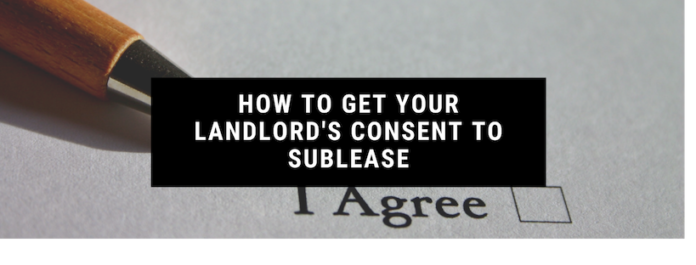“Ah, I’m so excited!”
Setting the phone down, smiling from ear to ear, Bree just got the best kind of news. Her job had just chosen her to help set up their new location, in London!
Traveling abroad had always been a dream of Bree’s, yet the timing couldn’t be worse. Just yesterday, she signed a renewal for her 12-month rental lease. How was she going to afford to live abroad, and pay for an empty apartment?
There are over 100 million renters in America, and many find themselves needing to get their landlords consent to sublease. Whether you’re like Bree and need to travel for work, or just need to be away for a while, subletting is a great way to save money.
Yet, getting permission from your landlord isn’t always as easy as you hope it will be. Many landlords will be hesitant to let a stranger into their property. That’s why it’s your job to present your case for subletting in the best way possible.
Read on to find out what information you need, to get your landlord to approve your request to sublet.
Know Your Tenants
Before you talk to your landlord, you’ll need to screen your tenant. Start by gathering all of the personal information you’ll need about your subtenant. Here’s a list of relevant information you should gather about your potential subtenant.
- Full legal name
- Date of birth
- Occupation
- Monthly income
- Do they have pets?
- Background check
- Renting history (evictions)
Having all of the facts will help you and your landlord, rest easy knowing the rent will be on time.
Say No to Pets
A normally calm dog could easily become anxious in its new surrounding. Destructive chewing is a common behavior in dogs, that are feeling high levels of stress.
If their little, or big doggie, starts feeling nervous, they may act out, and chew at your drywall or carpet. Avoid this headache, by giving a firm no, to allowing furry pets.
Background Checks
If you the individual who will be staying at your place isn’t family or a close friend, request a background check. The last thing you want to do is request permission for a wanted felon, to stay in your living quarters.
Rental History
Even if you do know the individual really well, it’s still a good idea to get a copy of their renting history. Have your subletter write out their previous addresses.
Make sure they include contact information for the landlord they had at each location. Next, it’s your responsibility to call the previous landlords, to inquire as to what kind of tenant, your candidate was.
What Does Your Lease Say?
So far we’ve been discussing, what information you’ll need to gather, before speaking to your landlord. Next, we’ll explain how to double check your lease, before going to your landlord.
Leases That Don’t Allow Subletting
Does your lease forbid subletting? Usually, a lease with a specific language about not allowing subletting is irreversible.
Your landlord probably has a strong reason for prohibiting subletters. They may have had bad past experience, or be unable to because of liability reasons.
A Lease That Allows Subletting
If your lease specifically says subletting is acceptable, you’ll still need to notify your landlord. It’s common courtesy to give your landlord at least 30 days of advanced notice for your plans. Many leases will even specifically stipulate that you have to give your landlord advanced notice for the sublease to be valid.
A Lease That Doesn’t Specify
Most leases have clear instructions about subletting. If your lease doesn’t give clear rules, you’ll need to prepare your case for consent. To do this you should put your request in writing.
Landlords Consent to Sublease
Now you need to make a written request to your landlord. Here are the items your written request needs to include.
- Why you want to sublet
- Dates your tenant will be there
- Name of subtenant
- Address of subtenant
- Your updated temporary address
- Copy of sublease agreement
Once you’ve completed your request, you’ll want to mail it to your landlord. Sending a physical letter helps your landlord see how seriously you are taking this matter.
After you mail your written request in, be patient, and allow time for your landlord to consider your proposition. If a week goes by without any contact from your landlord, resend the request using email.
Once you send the email, you can call your landlord to let them know it’s in their inbox. Make sure you don’t make your request over the phone when speaking to your landlord.
They are more likely to give you a hard “no”, without all of the facts you’ve gathered in front of them. Instead, just notify your landlord that you’ve mailed, and emailed them a request. Request that they please review the information, and contact you at their earliest convenience.
Preparing Your Place for Subletters
You found a great subletter, got consent from your landlord, now what? Immediately after you get permission from your landlord, you’ll want to begin preparing your place.
Here are a few of the things you can do to get ready.
- Clean every room
- Take photos
- Safety awareness
- Move your private belongings
First, you’ll want to clean every room thoroughly. Once your home is sparkling clean, take photos of your space. It’s best if you take multiple photos of every room in the house.
You need to have pictures of every room, in the event that your subletter causes any damage. If you use a phone, save a copy of the photos somewhere else, in the event, your phone is damaged. We suggest you email the pictures to yourself, so you’ll always have a digital copy.
Next, you’ll want to inspect your living space for any safety hazards.
Safety Awareness
The last thing you want is for your subletter to sustain an injury on your property. Not only would it be horrible to see someone get hurt, it could also cost you a lot of money. When your subletting, your acting as a type of landlord, and could be liable for any injuries.
Instead of dealing with a liability lawsuit, be proactive in making your home safety conscious. Here are the first safety items that need to be on your list.
- Fire extinguisher
- Smoke alarm
- Carbon monoxide detector
Make sure all of the above items are up to date, and have new batteries in them. Next, make sure the first aid kit is fully stocked, and easy to access.
What to Do with Your Belongings
After cleaning your apartment, and inspecting for safety hazards, you’ll want to start moving your belongings. Knowing what to do with your belongings, will mainly depend on three factors.
- How much stuff you have
- How long you’ll be away for
- Are you subletting to a stranger?
Do you have a lot of stuff? Or is there storage area available in unused closets, or drawers? Remember, the subletter is going to be bringing their own belongings to the home with them. Ask yourself, if there will be enough room for your stuff, and theirs.
If you don’t have room to store your belongings in your home, you might want to invest in a storage unit. If you’re only subletting for a couple of months, look for a flexible lease agreement. A flexible lease will help ensure that you won’t pay any more than you have to.
Decide Who Is in Charge
Getting your landlords consent to sublease, means accepting a new responsibility. You’ll be acting as the landlord, for the duration of the subletter’s lease.
As the acting landlord, it’ll be your job to know rental terminology, lease language, and eviction processes. You’ll also be responsible for collecting the rent from the subletter and giving it to your landlord.
If acting as the landlord sounds like an awful idea to you, don’t worry. Many times the landlord will prefer to be the main point of contact for the subletting period. If you prefer having the landlord be in charge, let them know this in your written request.




















